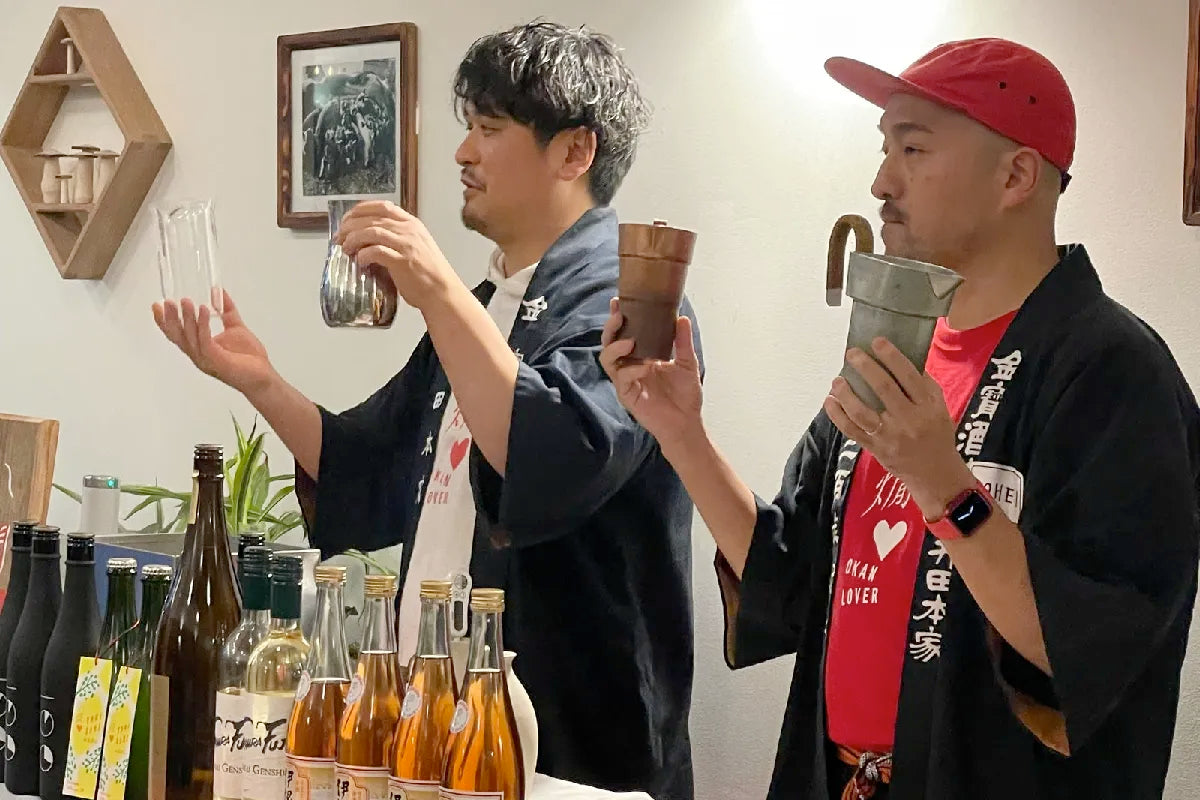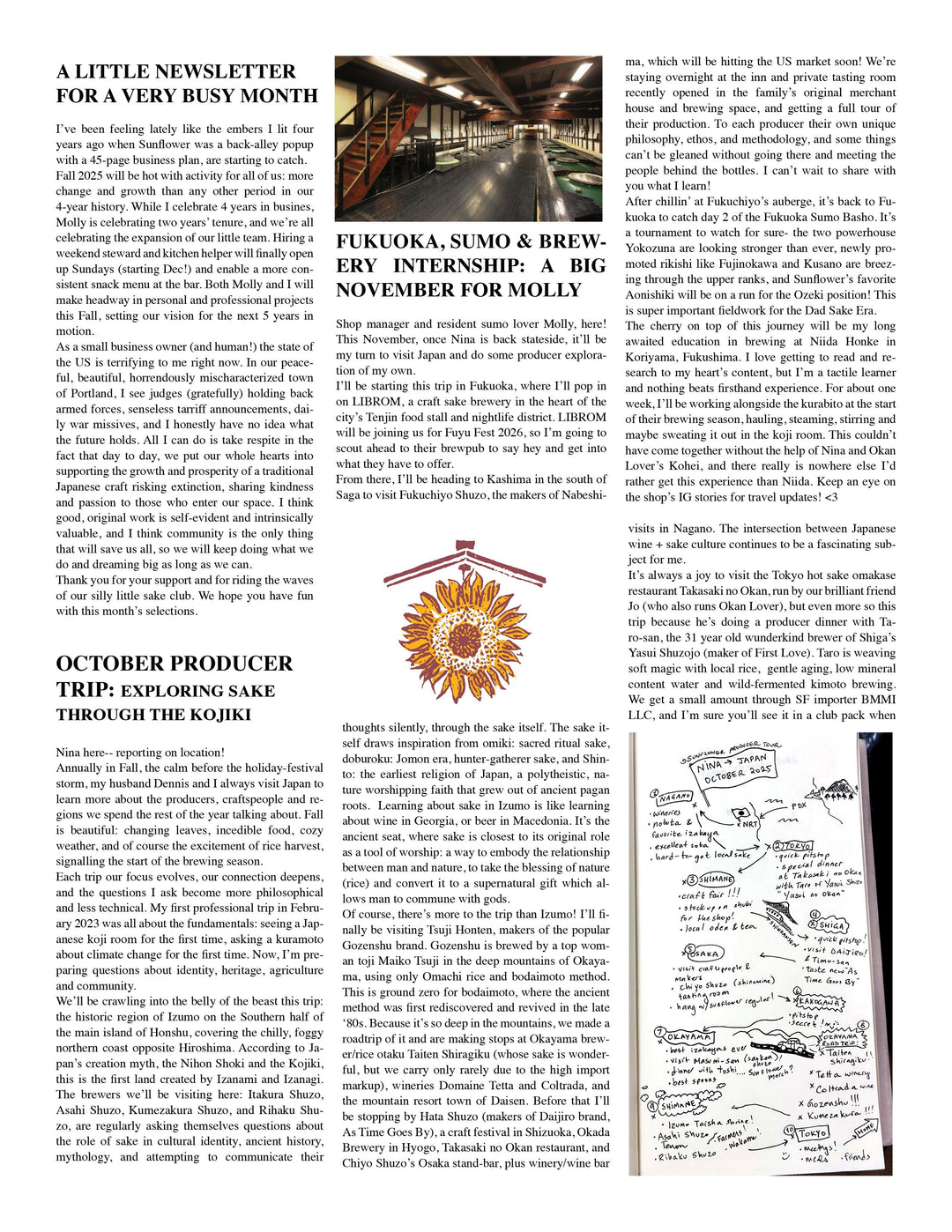Okan Lover Masterclass- Kanzake basics & class notes

To purchase tickets for the 2025 Okan Lover Masterclass, please visit this link
To attend one of the 2025 PDX, SF, or LA events, please visit this link for the full schedule
1.23.24 - Okan Lover Master Class
Chef Jo Takasaki @takasakinookan
“Akai” Kohei @akai.kohei
Menu
Matsunoi Tokubetsu Honjozo $28
Kaze no Mori Akitsuho 657 “White Label” Namagenshu $33
Niida Honke “Hyakunen Kijoshu” - NFS
Fukuraijyun 3Y Hon Mirin - $42 (720ml) + Terada Honke Katori 90 ($40)
Ota Tofu / Ota Soy Milk
Basics
We would like to introduce our traditional Japanese tools for heating sake.
まず、私達は道具の熱伝導を使って日本酒の味を 整えています。名前はちろりです 道具は錫、銅、ビーカーを使います。 日本酒の特徴に応じて道具を使い分けます。
First, we use heat-conducting vessels called “chirori” to manipulate the taste (flavor) of sake. The chirori are made of tin, copper, glass, and steel. We choose our chirori based on the characteristics of the sake,
in order to bring out its optimal flavor profile.
例えば 錫は熱伝導が丸い味わいになる特性があるので 煮込み料理のイメージです。
For example, tin has high thermal conductivity, so we will use tin when we would like to mellow and soften the flavor of the sake. Tin’s effect on sake is similar to stewing food.
銅は熱伝導が早く伝わるのでお酒にキレができる特性があるので焼き料理のイメージです。
Copper conducts heat very quickly. So we use copper when we want to enhance the sharpness and texture of the sake. Copper’s effect on sake is similar to grilling or searing food.
ビーカーは熱伝導が鈍いので柔らかくお酒に火が入る特性があるので 蒸し料理のイメージです。
Beakers are made of thin hard glass, conducting heat slowly and retaining very little heat in the vessel walls. We use beakers to soften the taste of the sake. Glass’ effect on sake is similar to steaming.
最近新しく使い始めたステンレス素材の
バーディも加わり4種類になりました
バーディの内側には、目に見えない粒子がありバーディで混ぜながら温めると味が構築されていく特性がありお酒の中の空気の様な物を抜いていくので揚げるお料理のイメージです。
Recently, Birdy (brand) released a stainless steel vessel which they call a decanter. We have adopted this into our practice as well, making for a total of four types of heating tools (chirori) in our kit.
From the Birdy product description:
With Birdy's unique polishing technology, the inner surface that is roughened at the level of 0.1 microns, helps the wine, as well as whiskey and sake to be more smooth and mellow.
When you use the Birdy to mix and heat sake, it enhances the flavor. The heat conduction is very fast, and as you swirl the sake in the bulbous base, the rough surface interacts with the chemistry of the liquid. The effect is reminiscent of deep frying, wherein air/water are removed from the food by cooking, thereby concentrating its flavor.
次にご紹介するのが、お酒を温めている機械の名前は 燗銅壺といいます。
Secondly, we introduce a machine termed “Kandouko” in Japanese, which is like a hot water bath. This is used to heat the sake.
二つの燗銅壺を使用していて、一つのお湯の温度は90℃で強火のイメージです。
We use two Kandouko, each set to a different temperature. One is 90 degrees Celsius, which is the image of a high heat: like roasting, it will affect the sake quickly and must be managed with care. Sake can be burned if one is not careful.
もう片方の温度は60℃で弱火のイメージです。
The other Kandouko is 60 degrees Celsius, which is the image of a low heat and can be used to warm the sake gently.
最後にお猪口と呼ばれるもので 最後の味の伝わり方を調整しています。これは、シェフが最後の一塩を振る感覚と同じイメージです。
Finally, we introduce a small sake cup called “Ochoko”. There are many kinds of Ochoko. We use this particular kind to give the best possible experience and flavor. It’s an image of the chef finishing the plating, salt and seasoning on a dish.
このように、熱伝導の扱い方を通して、私たちはどうやって火を入れたら日本酒の特徴を生かし美味しくできるのか日夜考えています。日本酒はシンプルで透明な液体に見えますが その味わい深さは素晴らしい可能性を秘めていることがわかります。
In this way, through the conduction of heat, we endeavor to best express the characteristics and flavor of the sake. Though Japanese sake appears simple, there is a great potential to diversify and appreciate its flavor.
多くの人は熱燗と料理は別物だと考えているかもしれません。しかし、私達は熱燗とお料理をボーダレスに考えています。お料理に火を入れるのもお酒に火を入れるのも同じ感覚で行っています。
Many people may think that cooking food and serving sake are different acts. But we believe that the principles for heating food and sake are the same. In addition, each can be used to “complete” the other. For us, there is no division between food and hot sake: they are one and the same.
お寿司に例えてみましょう。 私たちの提供するお料理は お寿司のネタの部分、そして熱燗はお寿司のシャリの部分です。
Let's take “sushi” as an example. The food we serve is like the fish, while is our hot sake is the rice.
私たちが提供するお料理とお酒は、お寿司のようにネタとシャリが口内で解ける感覚を味わっていただきたいです。
We would like to convey an experience in which the food and sake are completed together in your mouth, just like fish and sushi rice are joined together when you eat them.
本日のコースを楽しむために、まずお料理を食べてください。それから、口内に余韻が残っている状態でお酒を追いかけて飲んでください。素晴らしい食体験をお届けできることをお約束します。
For today’s menu, please eat the food first, then drink the sake while you still have the flavor of the dish in your mouth. We promise to share a wonderful dining experience with you.
ここまで説明を聞いてくださりありがとうございます。情熱的な説明でお腹がいっぱいになってしまったかもしれませんね。こんどはあなたのお腹をいっぱいにしたいと思います。
Thank you for listening to our explanation. Is your mind full of our passionate explanations? Now it’s time to fill your stomach.
Nina's class notes
Tools introduction
First we introduce the copper chirori. It has a drying, sharpening, crisping effect. The image is one of grilling.
Next we introduce the tin. It mellows the sake, as if roasting or braising it slowly.
Next we have the beaker. It conducts heat slowly and is best for slow infusions. The image is one of steaming food.
The Birdy appears to incorporate air well due to its shape and rough interior surface. The image is one of frying.
As we have two different water baths, it is as if we’re cooking with a high heat grill and a low heat oven. As for the serving cup, the ochoko, as you know different ochoko will provide a different experience. I prefer this ochoko as it is convenient to pre-warm, while the wide mouth, thin lip and smooth texture allows you to taste the best aspects of the sake. Plus you can see the color well.
Demo 1: Same sake, different temperature
First we begin with an example of a sake warmed to the same temperature (58 C) in all 4 different types of chirori. This is the Matsunoi Tokubetsu Honjozo, a dry Niigata honjozo at ~15.5% ABV with chiefly grain, woodsy, clean notes and a little background orchard fruit, but only faintly. All of the different samples are warmed over 80C heat (that’s the highest my own kandouko will go) while being stirred almost constantly throughout the warming process with his thermometer, checking frequently. Jo peeks at the thermometer but mostly he pulls the chirori to his nose to smell it, checking the aroma for signs of “doneness.”
Jo notes that the sake can burn if it’s not stirred– the outcome can taste rough if it isn’t managed thoughtfully.
Glass: a little sweet, soft, round, gentle.
Tin: although they are the same temperature, the sensation is one of greater heat. The mid palate seemed to drop out. Nutty and spicy. Someone says it is “wider at the expense of the middle”-- I agree with this.
Copper: sharper, as if the alcohol or acidity have gone up.
Birdy: flavorful but a little sharp.
Someone asks why he chose 58C: what is he looking for when he’s smelling it? “At a certain point, sometimes at multiple breakpoints, the alcohol smell goes down, it mellows out. It’s something you learn through tasting and experience, he says.
As they sit, these characteristics remain true and they can still be compared with obvious points of difference even at room temperature. The quality of the warming persists in the cooling.
Demo 2: Aromatic infusions
The next demonstration is heating Kaze no Mori 657 namazake with lime peel to flavor the sake with its essence. He chooses the glass beaker for this as it is generally his go-to for this kind of fresh namazake infusion, the sake itself having delicate floral characteristics that could easily be lost. He would normally use a 60C kandouko for this kind of warming but since we only have one he is just managing it more carefully.
Jo heats the kaze no mori, stirring regularly, until it has the aroma he’s looking for (53C) and adds lime peel, removing the sake from the kandouko. He swirls the lime peel for about 20 seconds over the heat. Why add the citrus at the end? “Its like sashimi– cold fish is like cold sake– oil won’t come out unless the sake is already hot. This way we can control the extraction when the extraction is able to take place.” Jo adds that it’s a good marriage when paired with a chaser of soda water. When you have the lime sake then soda, the effect is like a lemon sour.
The KNM umami is enhanced and the effervescence has mellowed out; the lime flavor comes through clearly and is really delicious and refreshing. Of course as it sits out with the lime, the flavor gets stronger and stronger.
Demo 3: Cold vs High heat
Kohei introduces Niida Honke Hyakunen Kijoshu, which they will be pouring next. The mascot is a frog, in consideration of their focus on sustainability and organic rice farming. They believe their rice is good enough that only a maximum of 15% needs to be removed for most of their products, wasting less of the grain. They sell sake to preserve the agricultural systems that harmonize with the maintenance of the mountain and its natural resources.
Hyakunen Kijoshu cool: a little citrusy, sweet, moderate acidity, relatively quick finish.
Heated to 70C in tin: much greater complexity is revealed as well as a different flavor profile. Sweetness is earthier, like a carrot or sweet potato, honeyed, lingering, mouth-coating, long finish. Much more interesting hot!
We ask why he chose the vessel he did in this case.
Mostly for namazake he heats in glass beaker, warm it up slowly so as to not shock its delicate aromatics or burn it. Unless he is pasteurizing it deliberately.
Otherwise if he were to heat it in copper– might add more sourness, acidity.
With tin, the taste becomes mild but it can add bitterness.
Birdy might break the taste. He’s not sure, he always has to experiment first to know.
He says that generally, natural sake (low polish, naturally farmed rice) always heats nicely.
Demo 4: blending
For this demo Jo is going to show us how he blends two sake to achieve a more interesting result. For example, when he was doing the pop-up dinner on the East Coast a few months prior, he did one or two blends and I wondered why, since he doesn’t usually do this at his restaurant. He said that his options for sake were limited so he had to use blending to achieve the food pairings.
Jo takes the Terada Honke Katori 90 Namagenshu (9/23 bottling date, this class took place 1/24) and heats it to 65C, I believe this was in tin. Then once it’s hot, he adds Tamagawa Time Machine 2021 in a ratio of roughly 1 part to 5-6 parts , which drops the sake to 60C, and serves. The flavor is excellent and spiced and rich, without tasting or smelling alcoholic at all. He says that blending sake cold doesn’t really work well, they don’t integrate completely, but they blend very well when warmed.
He is asked how he might pair this? “Pretty easily. With spices, Chinese cuisine, meat, pork. Maguro tuna with red vinegar rice. The umami is very strong so you can harmonize like with like. I think spice would be best.”
Demo 5: mirin cappuccino
At this point, I was no longer writing notes. But jo heated the mirin in the kandouko and also heated the Ota Tofu soymilk until it was hot, added a little mirin to it, then foamed it with a milk frother. He poured the milk froth on each person’s hot mirin until it was just a nice frothy soy milk cap. It made for a really lovely chai-like flavor. He also says he infuses the mirin typically with spices or tea or coffee beans.




